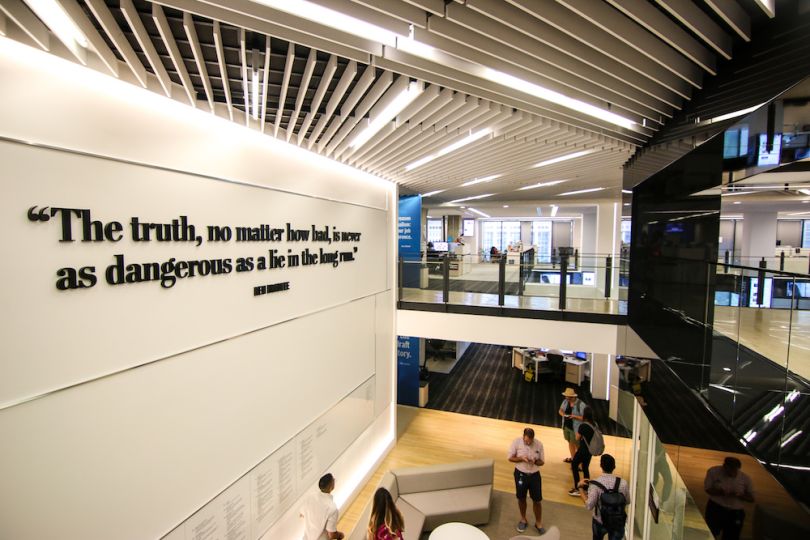Like most newspapers, the Washington Post’s migration to the web was messy.
Matthew Monahan, who’s been with the Post since 2011 and now works as a head of product on its tech team, described an IT department that, at the time, was running disparate websites — one for breaking news, another for blogs, a third for mobile — across a hodgepodge of legacy and homegrown technologies.
“If you want to transform an organization to build a real engineering culture, engineers don’t want to spend their days responding to Jira tickets asking for help updating a page or creating new sections,” he said. “You’re never going to get top-flight talent that way.”
After assessing its options across the content management system market, Monahan said the Post opted to build a brand new, internal CMS of its own, with an end goal to unlock the ability to perform complex management on a high-traffic webpage.
“We built a freestanding rendering system,” Monahan said. “It came coupled with an application where you could manage the entirety of your site, templates, page layout and the rest in a way that was totally friendly for business users and product people.”
The software, called Arc, became successful enough within the halls of the Washington Post that the newspaper began selling it to content teams externally. Today, some 250 people work on Arc, powering more than 800 sites worldwide. Monahan said they function as a software-as-a-service business within the newspaper.
“It pulled engineering out of debate and day-to-day management of the site.”
The software is an example of a new trend in content innovation: the headless CMS, a type of content management system poised to give an oft-neglected corner of the industry a tech-driven facelift. While this technology has given content creators new avenues to deliver work to readers, viewers and listeners, Monahan said it has also unlocked developer time and resources to take on more engaging problems.
As these underlying technologies advance, content companies are, for once, getting a taste of the tech boom.

Lopping the Head Off Your CMS
Content management systems are familiar enough to most of us. Free and open-source platforms like WordPress provide content-producing teams a place to pick templates, write and edit, and choose from an endless supply of plug-ins and widgets.
Those older systems are examples of what’s called a coupled CMS, where readers on the front end view the same system that developers and content managers use on the back end. The authoring and delivery structures are the same. But a headless CMS, like Arc, decouples the back and front ends, allowing for more versatile forms of content delivery.
“With a coupled CMS, you’re basically saying the templates that you build have to be coupled with the actual content you create,” said Monahan. “It makes it difficult to iterate on the front end, and it makes the site much more brittle if you’re running a high-traffic website and trying to push out changes.”
Coupled vs. Headless
- In a coupled CMS, users create content through tools like a WYSIWYG or HTML editor and save to a back-end database. The CMS then displays content using a built-in front-end delivery layer, like a WordPress template.
- A headless CMS gets rid of the front-end frameworks and templates, making it front-end agnostic. The CMS becomes a source of data which APIs retrieve to display in any number of formats — web, apps, syndicated partners, social media, even voice technology — without requiring a total rebuild.
As users find new preferred methods of content delivery, some people believe the headless CMS model will help businesses keep up with changing tastes. Jesse Martin, who works as a developer advocate at German startup GraphCMS, sees applications for the technology that go beyond the traditional publishing business.
“If you want to support an iOS device or an Alexa device — even if you wanted to build a custom skill — you could have the same content source driving all of these experiences that your developers are able to quickly iterate,” he said.
Moving from Administrating to Innovating
As content increasingly becomes a data source rather than a finished product in and of itself, Martin said companies like GraphCMS are capitalizing on industry shifts toward the API data query and manipulation language GraphQL.
“Adobe Experience Manager has already embraced GraphQL,” he said. “That’s really going to be the technology du jour for content, because it maps so cleanly to abstract data models.”
The language’s introspection — a core piece of its tooling — allows users to access every piece of data to which an API might respond.
“The graph nature allows you to start at any one point and move to any other point in that connected content graph,” he said. “That’s a great way to be able to explore the content you have.”’
But advancements in content-related technologies go beyond the perimeters of a CMS, headless or not. Across the industry, developers are working toward improvements on the sourcing and creation of content itself. The advent of cloud computing tools like AWS has helped developers spin up machine learning and computer vision technology without having to build an algorithm from scratch. For their part, CMS engineers look to these evolutions for inspiration.
“You can use ML to generate content, make it more personalized and to optimize your recommendations,” said Rashmi Mittal, who leads engineering efforts at Bangalore-based CMS company Quintype.
At the Washington Post, Monahan said there are continued investments in data science and research into new tools that might enhance content-related workflows, user experiences and back-end software tools.
“Let’s say I’m writing a story, and I want to find the perfect photo to go with it,” Monahan said. “We could suggest photos to you based on natural language processing, analysis of the text content, mapping those tags to topics and information that we know about the concept like a hierarchy, and then matching that against similar information from our media content that you might extract using computer vision.”
The bottom line, Monahan said, is that by producing content as a data source ready for any API, his tech teams have more time to work on product R&D.
“It pulled engineering out of debate and day-to-day management of the site,” he said, “and got them more focused on evolving user experience, AB testing, improving performance, the kind of difficult problems that will actually attract and grow an engineering culture.”



